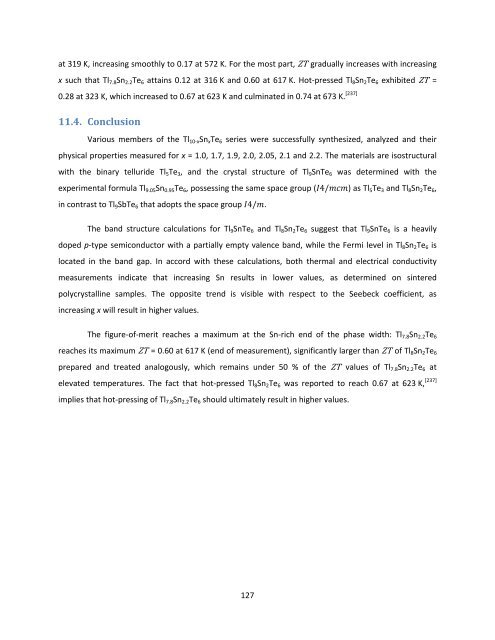Exploration and Optimization of Tellurium‐Based Thermoelectrics
Exploration and Optimization of Tellurium‐Based Thermoelectrics
Exploration and Optimization of Tellurium‐Based Thermoelectrics
Create successful ePaper yourself
Turn your PDF publications into a flip-book with our unique Google optimized e-Paper software.
at 319 K, increasing smoothly to 0.17 at 572 K. For the most part, ZT gradually increases with increasing<br />
x such that Tl7.8Sn2.2Te6 attains 0.12 at 316 K <strong>and</strong> 0.60 at 617 K. Hot‐pressed Tl8Sn2Te6 exhibited ZT =<br />
0.28 at 323 K, which increased to 0.67 at 623 K <strong>and</strong> culminated in 0.74 at 673 K. [237]<br />
11.4. Conclusion<br />
Various members <strong>of</strong> the Tl10‐xSnxTe6 series were successfully synthesized, analyzed <strong>and</strong> their<br />
physical properties measured for x = 1.0, 1.7, 1.9, 2.0, 2.05, 2.1 <strong>and</strong> 2.2. The materials are isostructural<br />
with the binary telluride Tl5Te3, <strong>and</strong> the crystal structure <strong>of</strong> Tl9SnTe6 was determined with the<br />
experimental formula Tl9.05Sn0.95Te6, possessing the same space group (4/) as Tl5Te3 <strong>and</strong> Tl8Sn2Te6,<br />
in contrast to Tl9SbTe6 that adopts the space group 4/.<br />
The b<strong>and</strong> structure calculations for Tl9SnTe6 <strong>and</strong> Tl8Sn2Te6 suggest that Tl9SnTe6 is a heavily<br />
doped p‐type semiconductor with a partially empty valence b<strong>and</strong>, while the Fermi level in Tl8Sn2Te6 is<br />
located in the b<strong>and</strong> gap. In accord with these calculations, both thermal <strong>and</strong> electrical conductivity<br />
measurements indicate that increasing Sn results in lower values, as determined on sintered<br />
polycrystalline samples. The opposite trend is visible with respect to the Seebeck coefficient, as<br />
increasing x will result in higher values.<br />
The figure‐<strong>of</strong>‐merit reaches a maximum at the Sn‐rich end <strong>of</strong> the phase width: Tl7.8Sn2.2Te6<br />
reaches its maximum ZT = 0.60 at 617 K (end <strong>of</strong> measurement), significantly larger than ZT <strong>of</strong> Tl8Sn2Te6<br />
prepared <strong>and</strong> treated analogously, which remains under 50 % <strong>of</strong> the ZT values <strong>of</strong> Tl7.8Sn2.2Te6 at<br />
elevated temperatures. The fact that hot‐pressed Tl8Sn2Te6 was reported to reach 0.67 at 623 K, [237]<br />
implies that hot‐pressing <strong>of</strong> Tl7.8Sn2.2Te6 should ultimately result in higher values.<br />
127
















